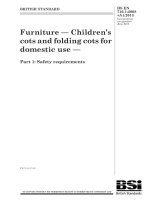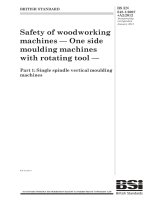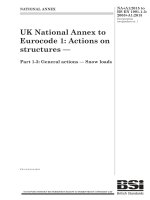Bsi bs en 62343 1 3 2013
Bạn đang xem bản rút gọn của tài liệu. Xem và tải ngay bản đầy đủ của tài liệu tại đây (1.07 MB, 16 trang )
BS EN 62343-1-3:2013
BSI Standards Publication
Dynamic modules
Part 1-3: Performance standards —
Dynamic gain tilt equalizer
(non-connectorized)
BRITISH STANDARD
BS EN 62343-1-3:2013
National foreword
This British Standard is the UK implementation of EN 62343-1-3:2013. It is
identical to IEC 62343-1-3:2012. It supersedes BS EN 62343-1-3:2006 which
is withdrawn.
The UK participation in its preparation was entrusted by Technical Committee
GEL/86, Fibre optics, to Subcommittee GEL/86/3, Fibre optic systems and
active devices.
A list of organizations represented on this committee can be obtained on
request to its secretary.
This publication does not purport to include all the necessary provisions of a
contract. Users are responsible for its correct application.
© The British Standards Institution 2013
Published by BSI Standards Limited 2013
ISBN 978 0 580 77668 7
ICS 33.180.01; 33.180.99
Compliance with a British Standard cannot confer immunity from
legal obligations.
This British Standard was published under the authority of the Standards
Policy and Strategy Committee on 30 April 2013.
Amendments issued since publication
Amd. No.
Date
Text affected
BS EN 62343-1-3:2013
EN 62343-1-3
EUROPEAN STANDARD
NORME EUROPÉENNE
EUROPÄISCHE NORM
March 2013
ICS 33.180.01; 33.180.99
Supersedes EN 62343-1-3:2006
English version
Dynamic modules Part 1-3: Performance standards Dynamic gain tilt equalizer (non-connectorized)
(IEC 62343-1-3:2012)
Modules dynamiques Partie 1-3: Normes de performance Egaliseur dynamique de basculement de
gain (non-connectorisé)
(CEI 62343-1-3:2012)
Dynamische Module Teil 1-3: Betriebsverhalten Dynamischer Equalizer mit schräglagen
Verstärkung (nicht mit Steckern versehen)
(IEC 62343-1-3:2012)
This European Standard was approved by CENELEC on 2013-01-09. CENELEC members are bound to comply
with the CEN/CENELEC Internal Regulations which stipulate the conditions for giving this European Standard
the status of a national standard without any alteration.
Up-to-date lists and bibliographical references concerning such national standards may be obtained on
application to the CEN-CENELEC Management Centre or to any CENELEC member.
This European Standard exists in three official versions (English, French, German). A version in any other
language made by translation under the responsibility of a CENELEC member into its own language and notified
to the CEN-CENELEC Management Centre has the same status as the official versions.
CENELEC members are the national electrotechnical committees of Austria, Belgium, Bulgaria, Croatia, Cyprus,
the Czech Republic, Denmark, Estonia, Finland, Former Yugoslav Republic of Macedonia, France, Germany,
Greece, Hungary, Iceland, Ireland, Italy, Latvia, Lithuania, Luxembourg, Malta, the Netherlands, Norway, Poland,
Portugal, Romania, Slovakia, Slovenia, Spain, Sweden, Switzerland, Turkey and the United Kingdom.
CENELEC
European Committee for Electrotechnical Standardization
Comité Européen de Normalisation Electrotechnique
Europäisches Komitee für Elektrotechnische Normung
Management Centre: Avenue Marnix 17, B - 1000 Brussels
© 2013 CENELEC -
All rights of exploitation in any form and by any means reserved worldwide for CENELEC members.
Ref. No. EN 62343-1-3:2013 E
BS EN 62343-1-3:2013
EN 62343-1-3:2013
-2-
Foreword
The text of document 86C/1077/CDV, future edition 2 of IEC 62343-1-3, prepared by SC 86C, "Fibre optic
systems and active devices", of IEC TC 86, "Fibre optics" was submitted to the IEC-CENELEC parallel
vote and approved by CENELEC as EN 62343-1-3:2013.
The following dates are fixed:
•
•
latest date by which the document has
to be implemented at national level by
publication of an identical national
standard or by endorsement
latest date by which the national
standards conflicting with the
document have to be withdrawn
(dop)
2013-10-09
(dow)
2016-01-09
This document supersedes EN 62343-1-3:2006.
EN 62343-1-3:2013 includes the following significant technical changes with respect to EN 62343-13:2006:
a) a change in the title removing the environmental category;
b) the addition of Clause 4, Operating and storage conditions;
c) the inclusion of spectral bands in Clause 5, Test;
d) a definition of the wavelength range for test requirements in Clause 5, Test;
e) the removal of the environment tests from the test details and requirements.
Attention is drawn to the possibility that some of the elements of this document may be the subject of
patent rights. CENELEC [and/or CEN] shall not be held responsible for identifying any or all such patent
rights.
Endorsement notice
The text of the International Standard IEC 62343-1-3:2012 was approved by CENELEC as a European
Standard without any modification.
In the official version, for Bibliography, the following note has to be added for the standard indicated:
IEC 61753-1
NOTE Harmonized as EN 61753-1.
-3-
BS EN 62343-1-3:2013
EN 62343-1-3:2013
Annex ZA
(normative)
Normative references to international publications
with their corresponding European publications
The following documents, in whole or in part, are normatively referenced in this document and are
indispensable for its application. For dated references, only the edition cited applies. For undated
references, the latest edition of the referenced document (including any amendments) applies.
NOTE When an international publication has been modified by common modifications, indicated by (mod), the relevant EN/HD
applies.
Publication
Year
Title
EN/HD
Year
IEC 61300-2-14
-
Fibre optic interconnecting devices and
passive components - Basic test and
measurement procedures Part 2-14: Tests - High optical power
EN 61300-2-14
-
IEC 61300-3-2
-
Fibre optic interconnecting devices and
EN 61300-3-2
passive components - Basic test and
measurement procedures Part 3-2: Examinations and measurements Polarization dependent loss in a single-mode
fibre optic device
-
IEC 61300-3-6
-
Fibre optic interconnecting devices and
passive components - Basic test and
measurement procedures Part 3-6: Examinations and measurements Return loss
EN 61300-3-6
-
IEC 61300-3-7
-
Fibre optic interconnecting devices and
passive components - Basic test and
measurement procedures Part 3-7: Examinations and measurements Wavelength dependence of attenuation and
return loss of single mode components
EN 61300-3-7
-
IEC 61300-3-32
-
Fibre optic interconnecting devices and
EN 61300-3-32
passive components - Basic test and
measurement procedures Part 3-32: Examinations and measurements Polarisation mode dispersion measurement
for passive optical components
-
IEC 61300-3-38
-
Fibre optic interconnecting devices and
EN 61300-3-38
passive components - Basic test and
measurement procedures Part 3-38:Examinations and measurements Group delay, chromatic dispersion and phase
ripple
-
IEC 61753-021-2
-
Fibre optic interconnecting devices and
EN 61753-021-2
passive components performance standard Part 021-2: Grade C/3 single-mode fibre optic
connectors for category C - Controlled
environment
-
IEC 61753-022-2
-
Fibre optic interconnecting devices and
EN 61753-022-2
passive components - Performance standard Part 022-2: Fibre optic connectors terminated
on multimode fibre for category C - Controlled
environment
-
BS EN 62343-1-3:2013
EN 62343-1-3:2013
-4-
Publication
IEC 62343-5-1
Year
-
Title
Dynamic modules - Test methods Part 5-1: Dynamic gain tilt equalizer Response time measurement
EN/HD
EN 62343-5-1
Year
-
ITU-T
Recommendation
G.692
-
Optical interfaces for multichannel systems
with optical amplifiers
-
-
BS EN 62343-1-3:2013
–2–
62343-1-3 © IEC:2012
CONTENTS
1
Scope ............................................................................................................................... 5
2
Normative references ....................................................................................................... 5
3
Terms and definitions ....................................................................................................... 6
4
Operating and storage conditions ..................................................................................... 7
5
4.1 Operating conditions ............................................................................................... 7
4.2 Storage environmental conditions ............................................................................ 7
Test .................................................................................................................................. 8
6
Test report ........................................................................................................................ 8
7
Performance requirements ............................................................................................... 8
7.1 Dimensions ............................................................................................................. 8
7.2 Sample size ............................................................................................................ 8
7.3 Test details and requirements ................................................................................. 8
Bibliography .......................................................................................................................... 11
Table 1 – Operating conditions ............................................................................................... 7
Table 2 – Storage environmental conditions ............................................................................ 7
Table 3 – Test details and requirements ................................................................................. 9
BS EN 62343-1-3:2013
62343-1-3 © IEC:2012
–5–
DYNAMIC MODULES –
Part 1-3: Performance standards –
Dynamic gain tilt equalizer (non-connectorized)
1
Scope
This part of IEC 62343 contains the guideline minimum initialization test and measurement
requirements and severities, for a dynamic gain tilt equalizer (DGTE).
A DGTE is used in an optical amplifier, which operates in C-band and/or L-band, to control the
output power of the amplifier to be nominally flat. The operating wavelength range of a DGTE
is wider than or equal to 35 nm.
2
Normative references
The following documents, in whole or in part, are normatively referenced in this document and
are indispensable for its application. For dated references, only the edition cited applies. For
undated references, the latest edition of the referenced document (including any
amendments) applies.
IEC 61300-2-14, Fibre optic interconnecting devices and passive components – Basic test
and measurement procedures – Part 2-14: Tests – Optical power handling and damage
threshold characterization
IEC 61300-3-2, Fibre optic interconnecting devices and passive components – Basic test and
measurement procedures – Part 3-2: Examinations and measurements – Polarization
dependent loss in a single-mode fibre optic device
IEC 61300-3-6, Fibre optic interconnecting devices and passive components – Basic test and
measurement procedures – Part 3-6: Examinations and measurements – Return loss
IEC 61300-3-7, Fibre optic interconnecting devices and passive components – Basic test and
measurement procedures – Part 3-7: Examinations and measurements – Wavelength
dependence of attenuation and return loss of single mode components
IEC 61300-3-32, Fibre optic interconnecting devices and passive components – Basic test
and measurement procedures – Part 3-32: Examinations and measurements – Polarization
mode dispersion measurement for passive optical components
IEC 61300-3-38, Fibre optic interconnecting devices and passive components – Basic test
and measurement procedures – Part 3-38: Examinations and measurements – Group delay,
chromatic dispersion and phase ripple
IEC 61753-021-2, Fibre optic interconnecting devices and passive components performance
standard – Part 021-2: Grade C/3 single-mode fibre optic connectors for category C –
Controlled environment
BS EN 62343-1-3:2013
–6–
62343-1-3 © IEC:2012
IEC 61753-022-2, Fibre optic interconnecting devices and passive components performance
standard – Part 022-2: Fibre optic connectors terminated on multimode fibre for category C –
Controlled environment
IEC 62343-5-1, Dynamic modules – Test methods – Part 5-1: Dynamic gain tilt equalizer –
Response time measurement
ITU-T Recommendation G.692, Optical interfaces for multichannel systems with optical
amplifiers
3
Terms and definitions
For the purposes of this document, the following terms and definitions apply.
3.1
dynamic spectral equalizer
DSE
two port in-line dynamic module that converts an input signal with time-varying spectral shape
into an output signal in which spectral shape is nominally flat, or is set for a required spectral
shape for pre-emphasis
3.2
dynamic gain tilt equalizer
DGTE
dynamic spectral equalizer used in an optical amplifier that converts input signals with timevarying gain tilt into output signals in which gain tilt is nominally flat, or is set for a required
gain tilt
3.3
operating wavelength range
specified range of wavelengths about a nominal operating wavelength within which a dynamic
module is designed to operate with the specified performances
3.4
dynamic gain tilt range
difference between the maximum and minimum deviation of attenuation over operating
wavelength range, to which the dynamic gain tilt equalizer can be set
3.5
positive slope type
type of DGTE for which dynamic gain tilt range can be set for positive gain tilt
3.6
negative slope type
type of DGTE for which dynamic gain tilt range can be set for negative gain tilt
3.7
both slope type
type of DGTE to which dynamic gain tilt range can be set for both positive and negative gain
tilt
3.8
slope linearity
maximum deviation of attenuation between the spectral shape by dynamic gain tilt equalizer
and linear slope over the operating wavelength range
BS EN 62343-1-3:2013
62343-1-3 © IEC:2012
–7–
3.9
gain tilt settle time
longest elapsed time it takes a dynamic gain tilt equalizer to change a gain tilt setting from an
arbitrary initial gain tilt value to a desired final gain tilt value, when the resulting gain tilt target
tolerance is met
4
Operating and storage conditions
4.1
Operating conditions
Table 1 shows minimum requirements of operating conditions for dynamic gain tilt equalizers
for commercial use.
Table 1 – Operating conditions
Items
Conditions
Operating temperature range
–10 °C to 60 °C, case temperature
Operating relative humidity range
5 % to 85 % RH.
a
Absolute humidity is within 24 g per 1 kg dry air
Operating shock
b
Operating vibration
400 m/s 2 , 5 ms
b
50 Hz – 500 Hz,
20 m/s 2
a
A position on the surface of a module to be measured for temperature shall be defined. When a dynamic
module does not emit heat, a position need not be defined.
b
If the modules are critical to satisfy the severities of operating shock and operating vibration conditions, the
following severities can be adopted:
–
–
4.2
for the axis of the perpendicular direction of the mounting surfaces
•
400 m/s 2 , 5 ms for operating shock,
•
50 Hz – 500 Hz, 20 m/s 2 for operating vibration;
for the two other axes of parallel direction of the mounting surfaces
•
200 m/s 2 , 5 ms for operating shock,
•
50 Hz – 500 Hz, 10 m/s 2 for operating vibration.
Storage environmental conditions
Table 2 shows minimum requirements of storage environmental conditions for dynamic gain
tilt equalizers for commercial use.
Table 2 – Storage environmental conditions
Items
Storage temperature range
Storage relative humidity range
Conditions
– 20 °C à 70 °C, ambient
5 % to 85 % RH.
The absolute humidity is within 24 g per 1 kg dry air
Non-operating shock (for components)
5 000 m/s 2 , 1 ms, half sine, for less than or equal to
0,125 kg weight
Non-operating shock (for modules)
2 000 m/s 2 , 1,33 ms, half sine for more than 0,125 kg
weight, and less than or equal to 0,225 kg weight.
500 m/s 2 , 5 ms, half sine for more than 0,225 kg weight,
and less than or equal to 1 kg weight
Non-operating vibration
10 Hz – 55 Hz for frequency, 1,52 mm for amplitude
BS EN 62343-1-3:2013
–8–
Items
Non-operating impact (drop, for modules)
62343-1-3 © IEC:2012
Conditions
100 mm height for 1 kg to 10 kg weight,
75 mm height for 10 kg to 25 kg weight
Transportation impact (drop, packed)
1 m height
Transportation vibration (packed)
5 Hz – 20 Hz for frequency, 0,1 m/s 2 /Hz
(2 m/s 2 at 20 Hz)
20 Hz – 200 Hz, -3 dB/octave
5
Test
The characterization of a dynamic gain tilt equalizer requires demonstration that those
components or features within the module, together with that of the module itself, are capable
of yielding the performance requirements as defined in the relevant specification.
Where it can be adequately demonstrated that components or features have previously met
all of the requirements of a specific performance standard category, they may be declared as
complying with that performance standard. This may obviate the need for repeat testing of
components or features in such cases. Where this occurs, reference shall be made to the
relevant test reports or documentations.
All tests are to be carried out to validate performance over the required operating wavelength
range (wider than or equal to 35 nm). As a result, single or multiple spectral bands may be
chosen for the qualification and differing target specifications may be assigned to each
spectral band (C-band or L-band).
6
Test report
Fully documented test reports and supporting evidence shall be prepared and be available for
inspections as evidence that the tests have been carried out and complied with.
7
7.1
Performance requirements
Dimensions
Dimensions shall comply either with an appropriate IEC interface standard or with those given
in the manufacturer's drawings, where the IEC interface standard does not exist or cannot be
used.
7.2
Sample size
Three (3) DGTE modules are used in each test. The tests may be performed individually or in
sequential order.
The test sample size and sequencing requirements for the module components shall be
defined in the relevant specification.
7.3
Test details and requirements
The requirements are given only for non-connectorized DGTE devices. For connectorized
modules, the connector performances shall be in compliance with IEC 61753-021-2 and
IEC 61753-022-2.
The channel spacings, unless otherwise specified, shall be in accordance with ITU-T
Recommendation G.692.
BS EN 62343-1-3:2013
62343-1-3 © IEC:2012
–9–
The test details and requirements for performance standard are shown in Table 3.
For sequential testing, the data shall be analysed to determine the pass or failure for each
test.
The following table provides figures as a guideline of performance requirements and are not
indicative of values that must be met in an operational environment.
Table 3 – Test details and requirements
No
1
Tests
Dynamic gain tilt range
IEC 61300-3-7
Requirements
From –4 dB to +4 dB for both
slopes type
From 0 dB to +4 dB for positive
slope type
From –4 dB to 0 dB for negative
slope type
2
Insertion loss
IEC 61300-3-7
≤ 5 dB for positive/negative slope
type. The insertion loss for
positive /negative slope type is
defined as the insertion loss at
longest operating wavelength, and
shortest operating wavelength,
respectively.
≤ 2,5 dB for both slope type
The insertion loss for both slope
type is defined as the insertion
loss at the centre wavelength of
operating wavelength range.
3
4
Slope linearity
Details
61300-3-7, method B
TLS (tuneable light source);
Wavelength uncertainty:
≤ 0,1 nm, Wavelength increment:
≤ 0,5 nm.
Other details: accordance with
IEC 61300-3-7.
Dynamic gain tilt range is
calculated from the interpolated
line by least square method over
operating wavelength range.
Dynamic gain tile range is the
differences of optical attenuation
of the interpolated line between
at the longest wavelength and at
the shortest wavelength.
Insertion loss is calculated as
average of optical attenuation
over all polarization state.
IEC 61300-3-7
≤ 0,8 dB
Slope linearity shall be met over
operating wavelength range
Return loss
> 45 dB for class W
Branching devices method.
IEC 61300-3-6
Return loss shall be measured for
input port and output port.
Branching device:
Nominal splitting ratio: 50/50 %
Directivity: > 60 dB
Slope linearity is calculated as
the maximum deviation of optical
attenuation between the
interpolated line and the
measured optical attenuation
over operating wavelength range
Source:
Type: LD
Centre wavelength:
1 550 nm ± 20 nm or 1 590 nm ±
20 nm.
Spectral width: < 20 nm.
Stability at operating wavelength
in a period of at least 1 h: within
± 0,05 dB.
Detector:
Sensitivity: < –80 dBm
Linearity: within ±0,05 dB
Other port not under test shall be
terminated to avoid unwanted
reflections contributing to the
measurement
BS EN 62343-1-3:2013
– 10 –
No
5
Tests
Polarization dependent loss
IEC 61300-3-2
62343-1-3 © IEC:2012
Requirements
≤ 0,3 dB over operating
wavelength range
Details
All state method or Mueller
matrix method.
Source: TLS over operating
wavelength range.
Other details: in accordance with
IEC 61300-3-2
6
Chromatic dispersion
IEC 61300-3-38
≤ ±2 ps/nm over operating
wavelength range.
Modulation phase shift method or
swept wavelength interferometry
method.
Other details: accordance with
IEC 61300-3-38
7
Polarization mode dispersion
≤ 0,5 ps.
IEC 61300-3-32
Stokes parameter equation
method including JME (Jones
Matrix Eigenanalysis) and PSA
(Poincare sphere analysis).
Other details: accordance with
IEC 61300-3-32
8
Gain tilt settle time
≤ 100 ms
IEC 62343-5-1
Target power tolerance (Y): 5 %.
Initial power tolerance (X): 5 %
Other details: accordance with
IEC 62343-5-1
9
Power consumption
≤1W
Method under consideration
10
Optical power handling and
damage threshold
characterization.
+23 dBm
Method 3.
IEC 61300-2-14
Optical source:
Wavelength: centre wavelength
± 20 nm of operating wavelength
range.
Duration time: 2 h
Temperature: 70 °C
BS EN 62343-1-3:2013
62343-1-3 © IEC:2012
– 11 –
Bibliography
IEC 61753-1, Fibre optic interconnecting devices and passive components performance
standard – Part 1: General and guidance for performance standards
ITU-T Recommendation G.671, Transmission characteristics of optical components and
subsystems
ITU-T Recommendation G.694.1, Spectral grids for WDM applications: DWDM frequency grid
_____________
This page deliberately left blank
NO COPYING WITHOUT BSI PERMISSION EXCEPT AS PERMITTED BY COPYRIGHT LAW
British Standards Institution (BSI)
BSI is the national body responsible for preparing British Standards and other
standards-related publications, information and services.
BSI is incorporated by Royal Charter. British Standards and other standardization
products are published by BSI Standards Limited.
About us
Revisions
We bring together business, industry, government, consumers, innovators
and others to shape their combined experience and expertise into standards
-based solutions.
Our British Standards and other publications are updated by amendment or revision.
The knowledge embodied in our standards has been carefully assembled in
a dependable format and refined through our open consultation process.
Organizations of all sizes and across all sectors choose standards to help
them achieve their goals.
Information on standards
We can provide you with the knowledge that your organization needs
to succeed. Find out more about British Standards by visiting our website at
bsigroup.com/standards or contacting our Customer Services team or
Knowledge Centre.
Buying standards
You can buy and download PDF versions of BSI publications, including British
and adopted European and international standards, through our website at
bsigroup.com/shop, where hard copies can also be purchased.
If you need international and foreign standards from other Standards Development
Organizations, hard copies can be ordered from our Customer Services team.
Subscriptions
Our range of subscription services are designed to make using standards
easier for you. For further information on our subscription products go to
bsigroup.com/subscriptions.
With British Standards Online (BSOL) you’ll have instant access to over 55,000
British and adopted European and international standards from your desktop.
It’s available 24/7 and is refreshed daily so you’ll always be up to date.
You can keep in touch with standards developments and receive substantial
discounts on the purchase price of standards, both in single copy and subscription
format, by becoming a BSI Subscribing Member.
PLUS is an updating service exclusive to BSI Subscribing Members. You will
automatically receive the latest hard copy of your standards when they’re
revised or replaced.
To find out more about becoming a BSI Subscribing Member and the benefits
of membership, please visit bsigroup.com/shop.
With a Multi-User Network Licence (MUNL) you are able to host standards
publications on your intranet. Licences can cover as few or as many users as you
wish. With updates supplied as soon as they’re available, you can be sure your
documentation is current. For further information, email
BSI Group Headquarters
389 Chiswick High Road London W4 4AL UK
We continually improve the quality of our products and services to benefit your
business. If you find an inaccuracy or ambiguity within a British Standard or other
BSI publication please inform the Knowledge Centre.
Copyright
All the data, software and documentation set out in all British Standards and
other BSI publications are the property of and copyrighted by BSI, or some person
or entity that owns copyright in the information used (such as the international
standardization bodies) and has formally licensed such information to BSI for
commercial publication and use. Except as permitted under the Copyright, Designs
and Patents Act 1988 no extract may be reproduced, stored in a retrieval system
or transmitted in any form or by any means – electronic, photocopying, recording
or otherwise – without prior written permission from BSI. Details and advice can
be obtained from the Copyright & Licensing Department.
Useful Contacts:
Customer Services
Tel: +44 845 086 9001
Email (orders):
Email (enquiries):
Subscriptions
Tel: +44 845 086 9001
Email:
Knowledge Centre
Tel: +44 20 8996 7004
Email:
Copyright & Licensing
Tel: +44 20 8996 7070
Email:









